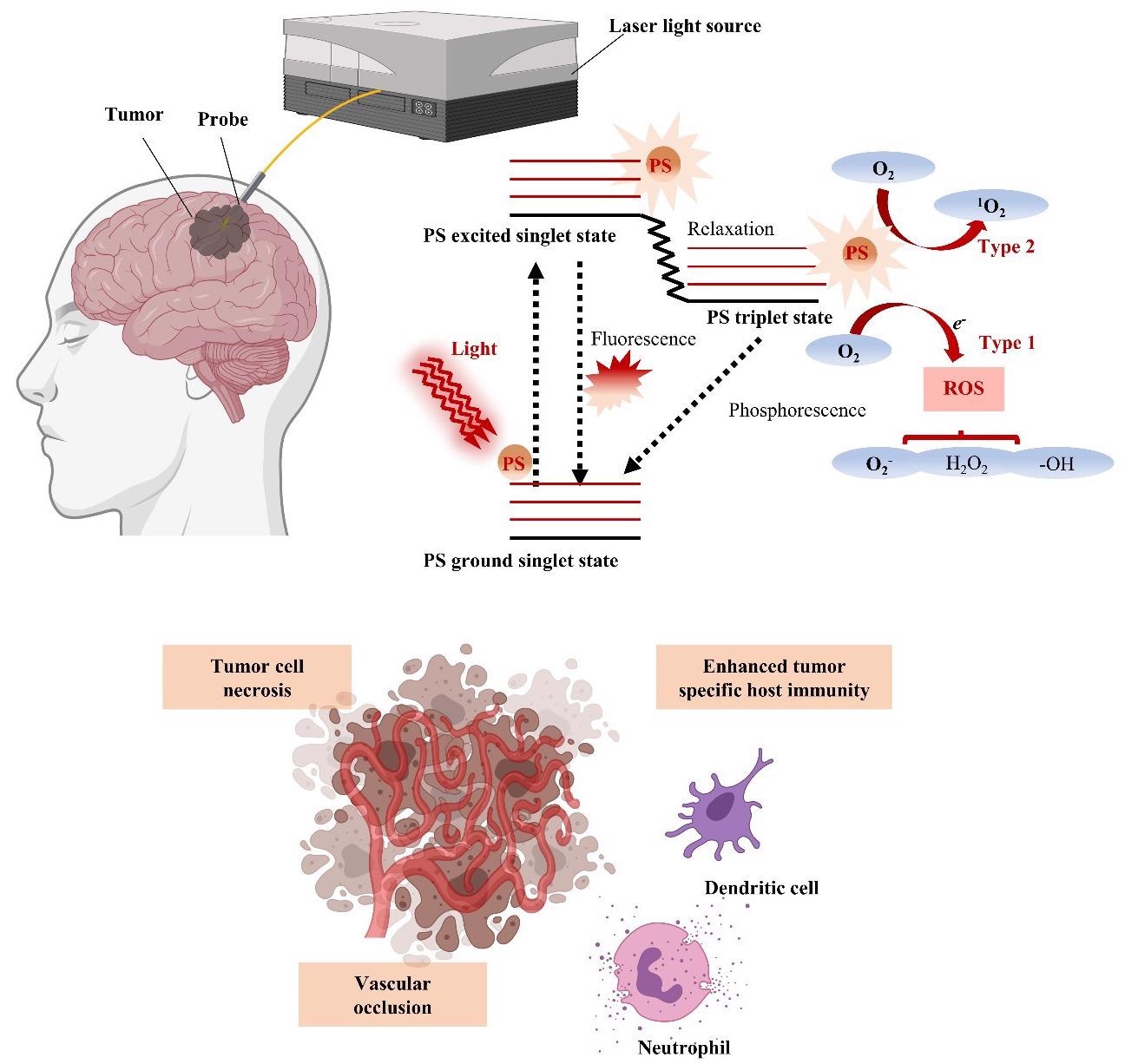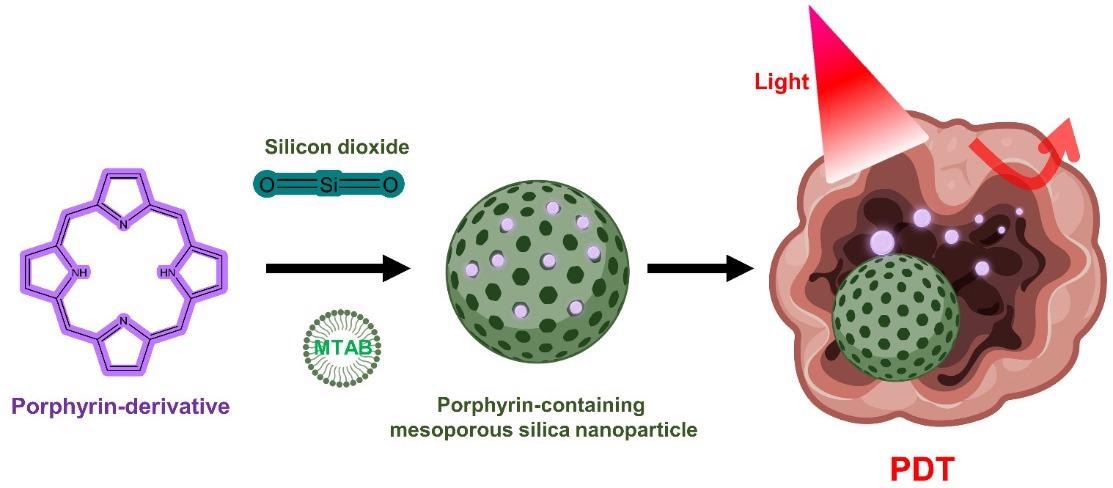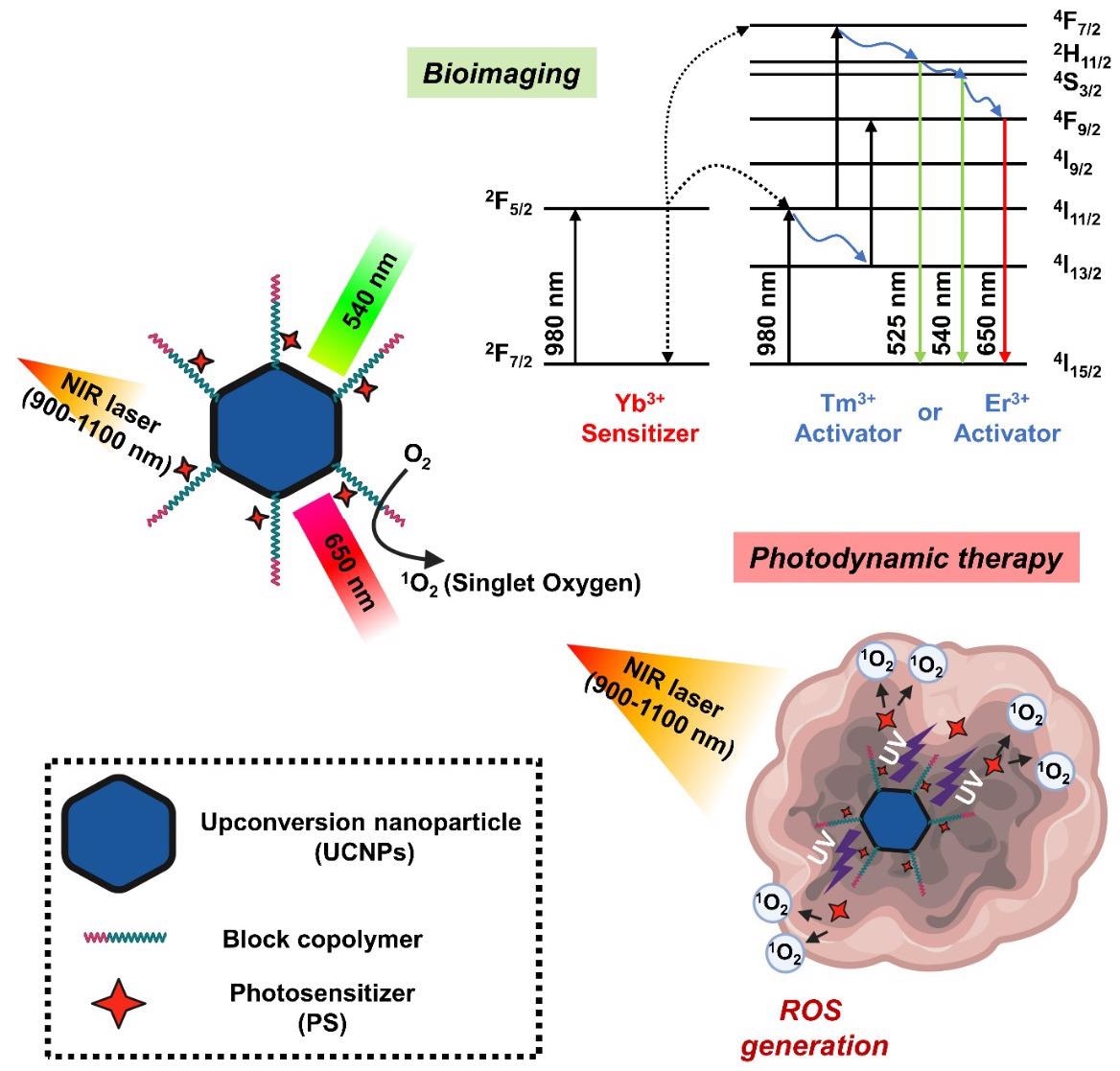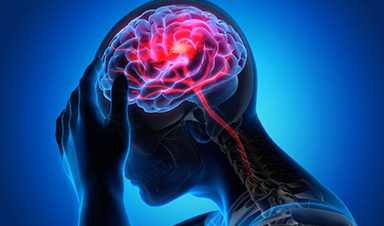A new approach to brain tumor treatment using photodynamic therapy (PDT) with nanotechnology has been explored in a review published in the journal Biomedicines. Unlike radiotherapy and surgical resection, PDT can treat micro-invasive areas and protect critical brain tissue with a high probability of success.
Conventional Methods using PDT
Photodynamic therapy is a type of phototherapy that uses light and sensitizing chemical agents in combination with oxygen molecules to induce cell death. It is a two-stage remedy that incorporates light energy with a medicine (photosensitizer) designed to kill cancer cells and precancerous cells after they have been activated by light.

Schematic illustration of photodynamic therapy (PDT) for GBM treatment with energy diagram of the oxygen dependent response. If the photosensitizer (PS) in the ground singlet state is excited by the light wavelength, then the PS in the excited singlet state can convert to the excited triplet state via intersystem crossing. In the presence of molecular oxygen, the PS in the triplet state can undergo a Type 1 or Type 2 redox reaction, producing reactive oxygen species (ROS) that cause tumor cell necrosis, vascular occlusion, and tumor-specific host immunity. © Kim, H., and Lee, D. (2022).
Photosensitizers are initiated by a specific wavelength energy, which is typically generated by a laser. PDT has been shown to be effective in treating a variety of tumors, including melanoma, squamous cell carcinoma, and multidrug-resistant lung and mammary tumors.
PDT with Its Limited Efficacy
Following other oncology implementations, the interest in PDT as a high-grade glioma diagnosis stems from the essence of tumor growth and the limited efficacy of modern treatment options to this population of patients. Although surgical removal, partial radiation, and chemotherapy are important treatments for intracranial tumors, the obtrusive growth patterns, especially in the cerebrum’s central region, make total resection difficult.
As opposed to surgical resection and radiation, PDT can treat micro-invasive regions while preserving sensitive brain areas. These potential benefits over conventional therapies have been shown to improve results in clinical situations with low overall survival and a high incidence of iatrogenic damage.

Porphyrin-containing mesoporous silica nanoparticles for PDT. © Kim, H., and Lee, D. (2022).
Nanomedicine as Opposed to Conventional Method
The rapidly growing areas of nanotechnology and nanomedicine are yielding nanostructured materials that may overcome the limitations of conventional clinical delivery methods. In fact, the existence of a functioning blood–brain barrier (BBB) inhibits therapeutic delivery to brain malignancies.
Many ways for temporarily opening the BBB by physical impact, including magnetic resonance (MR)-guided focussed ultrasound, have lately been researched to circumvent this barrier; however, this poses a technical problem.
One of the most promising solutions involves the utilization of multifunctional nanomedicines as drug delivery systems.
Advantages of Nanomedicine
The excellent physical and mechanical characteristics of nanocarriers vary based on their material, size, form (mesoporous microstructure, rod shape, particles), and ligand of choice. This enables enhanced brain-targeted administration of PS or therapeutic medicines.
Although many PS nanocapsules are still in the early phases of translation, major improvements in functional nanomedicines relying on BBB crossing have been accomplished in recent years.

Schematic diagram showing the mechanism of photodynamic therapy and bioimaging through long-wavelength to short-wavelength conversion of upconversion nanoparticles (UCNPs). © Kim, H., and Lee, D. (2022).
Another benefit of nanoparticles is that they may boost PS’s poor solubility, extend blood circulation, promote the targeted distribution and cellular absorption, and protect the medication from degradation.
Nanoparticles in PDT for Healing
Although contemporary PDT has considerably improved cancer patients’ quality of life and survival rates, it is critical to further enhance the therapeutic efficacy of nanocarriers to eliminate noticeable side effects.
In this respect, researchers have investigated a variety of nanocarriers, including polymers, liposomes, micelles, inorganic oxide, and new metal nanoparticles, to improve the therapeutic efficiency of photosensitizers.
First and foremost, nanocarriers must be used to effectively transport photosensitizers and singlet oxygen molecules to the target region in an ideal therapeutic range.
PDT is a dynamically evolving profession that is continually on the lookout for innovative technologies. To improve the efficacy and selectivity of PDT, molecular techniques based on nanotechnology are being explored. As a result, several novel organic and inorganic nanoparticles have already been discovered and produced for the targeted administration of photosensitizer medicines.
Nanoparticles may remedy the significant constraints of standard PS medication delivery.
Limitation of this Nanotechnology PDT
However, since intracranial brain tumors emerge from complex structures and distinct organs, such as those bordered by the blood–brain barrier, it is questionable if they can be completely removed using the same strategy as other cancers.
Further research is needed to determine if PDT may be utilized to treat malignant brain cancer that cannot be removed due to its location.
Ongoing research into the numerous PDTs described in this publication will decide whether breakthroughs in cancer research can reduce morbidity and mortality from intracranial malignancy and have the potential to change brain tumor therapy. As a result, although the development of new PDT technology is critical, establishing therapeutic guidelines via large-scale clinical practice should be prioritized.
Future Research in this Nanomedicine to Cure Brain Cancer
With the fast advancements in nanotechnology, researchers now have several synthetic approaches at their disposal to create gold nanoparticles with good shapes and characteristics for PDT applications.
In addition to the numerous physicochemical qualities listed above, the extra various synthesis potential should increase bioavailability and usefulness, indicating gold nanoparticles as a suitable choice for therapeutic cancer therapy.
News
Older chemical libraries show promise for fighting resistant strains of COVID-19 virus
SARS‑CoV‑2, the virus that causes COVID-19, continues to mutate, with some newer strains becoming less responsive to current antiviral treatments like Paxlovid. Now, University of California San Diego scientists and an international team of [...]
Lower doses of immunotherapy for skin cancer give better results, study suggests
According to a new study, lower doses of approved immunotherapy for malignant melanoma can give better results against tumors, while reducing side effects. This is reported by researchers at Karolinska Institutet in the Journal of the National [...]
Researchers highlight five pathways through which microplastics can harm the brain
Microplastics could be fueling neurodegenerative diseases like Alzheimer's and Parkinson's, with a new study highlighting five ways microplastics can trigger inflammation and damage in the brain. More than 57 million people live with dementia, [...]
Tiny Metal Nanodots Obliterate Cancer Cells While Largely Sparing Healthy Tissue
Scientists have developed tiny metal-oxide particles that push cancer cells past their stress limits while sparing healthy tissue. An international team led by RMIT University has developed tiny particles called nanodots, crafted from a metallic compound, [...]
Gold Nanoclusters Could Supercharge Quantum Computers
Researchers found that gold “super atoms” can behave like the atoms in top-tier quantum systems—only far easier to scale. These tiny clusters can be customized at the molecular level, offering a powerful, tunable foundation [...]
A single shot of HPV vaccine may be enough to fight cervical cancer, study finds
WASHINGTON -- A single HPV vaccination appears just as effective as two doses at preventing the viral infection that causes cervical cancer, researchers reported Wednesday. HPV, or human papillomavirus, is very common and spread [...]
New technique overcomes technological barrier in 3D brain imaging
Scientists at the Swiss Light Source SLS have succeeded in mapping a piece of brain tissue in 3D at unprecedented resolution using X-rays, non-destructively. The breakthrough overcomes a long-standing technological barrier that had limited [...]
Scientists Uncover Hidden Blood Pattern in Long COVID
Researchers found persistent microclot and NET structures in Long COVID blood that may explain long-lasting symptoms. Researchers examining Long COVID have identified a structural connection between circulating microclots and neutrophil extracellular traps (NETs). The [...]
This Cellular Trick Helps Cancer Spread, but Could Also Stop It
Groups of normal cbiells can sense far into their surroundings, helping explain cancer cell migration. Understanding this ability could lead to new ways to limit tumor spread. The tale of the princess and the [...]
New mRNA therapy targets drug-resistant pneumonia
Bacteria that multiply on surfaces are a major headache in health care when they gain a foothold on, for example, implants or in catheters. Researchers at Chalmers University of Technology in Sweden have found [...]
Current Heart Health Guidelines Are Failing To Catch a Deadly Genetic Killer
New research reveals that standard screening misses most people with a common inherited cholesterol disorder. A Mayo Clinic study reports that current genetic screening guidelines overlook most people who have familial hypercholesterolemia, an inherited disorder that [...]
Scientists Identify the Evolutionary “Purpose” of Consciousness
Summary: Researchers at Ruhr University Bochum explore why consciousness evolved and why different species developed it in distinct ways. By comparing humans with birds, they show that complex awareness may arise through different neural architectures yet [...]
Novel mRNA therapy curbs antibiotic-resistant infections in preclinical lung models
Researchers at the Icahn School of Medicine at Mount Sinai and collaborators have reported early success with a novel mRNA-based therapy designed to combat antibiotic-resistant bacteria. The findings, published in Nature Biotechnology, show that in [...]
New skin-permeable polymer delivers insulin without needles
A breakthrough zwitterionic polymer slips through the skin’s toughest barriers, carrying insulin deep into tissue and normalizing blood sugar, offering patients a painless alternative to daily injections. A recent study published in the journal Nature examines [...]
Multifunctional Nanogels: A Breakthrough in Antibacterial Strategies
Antibiotic resistance is a growing concern - from human health to crop survival. A new study successfully uses nanogels to target and almost entirely inhibit the bacteria P. Aeruginosa. Recently published in Angewandte Chemie, the study [...]
Nanoflowers rejuvenate old and damaged human cells by replacing their mitochondria
Biomedical researchers at Texas A&M University may have discovered a way to stop or even reverse the decline of cellular energy production—a finding that could have revolutionary effects across medicine. Dr. Akhilesh K. Gaharwar [...]





















